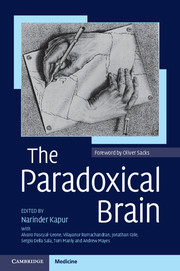Book contents
- Frontmatter
- Contents
- Acknowledgements
- Preface
- Foreword
- Author affiliations
- Abbreviations
- 1 The paradoxical nature of nature
- 2 Paradoxical effects of sensory loss
- 3 Paradoxical functional facilitation and recovery in neurological and psychiatric conditions
- 4 Paradoxes in neurorehabilitation
- 5 The paradoxical self
- 6 Paradoxical psychological functioning in early child development
- 7 Cognitive ageing: a positive perspective
- 8 Paradoxes of learning and memory
- 9 The paradox of human expertise: why experts get it wrong
- 10 Paradoxes in Parkinson's disease and other movement disorders
- 11 Paradoxical phenomena in epilepsy
- 12 Paradoxical creativity and adjustment in neurological conditions
- 13 Paradoxical functional facilitation with noninvasive brain stimulation
- 14 Unexpected benefits of allergies and cigarette smoking: two examples of paradox in neuroepidemiology
- 15 The paradox of autism: why does disability sometimes give rise to talent?
- 16 Paradoxes in creativity and psychiatric conditions
- 17 The paradox of psychosurgery to treat mental disorders
- 18 The paradox of electroconvulsive therapy
- 19 Paradoxes of comparative cognition
- 20 Paradoxical phenomena in brain plasticity
- 21 Immature neurons in the adult brain. Breaking all the rules
- 22 The paradoxical hippocampus: when forgetting helps learning
- 23 Paradoxical effects of drugs on cognitive function: the neuropsychopharmacology of the dopamine and other neurotransmitter systems
- 24 The paradoxical brain – so what?
- Index
- References
19 - Paradoxes of comparative cognition
Published online by Cambridge University Press: 05 December 2011
- Frontmatter
- Contents
- Acknowledgements
- Preface
- Foreword
- Author affiliations
- Abbreviations
- 1 The paradoxical nature of nature
- 2 Paradoxical effects of sensory loss
- 3 Paradoxical functional facilitation and recovery in neurological and psychiatric conditions
- 4 Paradoxes in neurorehabilitation
- 5 The paradoxical self
- 6 Paradoxical psychological functioning in early child development
- 7 Cognitive ageing: a positive perspective
- 8 Paradoxes of learning and memory
- 9 The paradox of human expertise: why experts get it wrong
- 10 Paradoxes in Parkinson's disease and other movement disorders
- 11 Paradoxical phenomena in epilepsy
- 12 Paradoxical creativity and adjustment in neurological conditions
- 13 Paradoxical functional facilitation with noninvasive brain stimulation
- 14 Unexpected benefits of allergies and cigarette smoking: two examples of paradox in neuroepidemiology
- 15 The paradox of autism: why does disability sometimes give rise to talent?
- 16 Paradoxes in creativity and psychiatric conditions
- 17 The paradox of psychosurgery to treat mental disorders
- 18 The paradox of electroconvulsive therapy
- 19 Paradoxes of comparative cognition
- 20 Paradoxical phenomena in brain plasticity
- 21 Immature neurons in the adult brain. Breaking all the rules
- 22 The paradoxical hippocampus: when forgetting helps learning
- 23 Paradoxical effects of drugs on cognitive function: the neuropsychopharmacology of the dopamine and other neurotransmitter systems
- 24 The paradoxical brain – so what?
- Index
- References
Summary
Summary
The scala naturae (latin for ‘natural ladder’) is a concept of the order of natural forms that is often referred to as the great chain of being. It dates from medieval Christianity, and applies a rigid hierarchical organization to all matter and life. At the bottom of this hierarchy is earth, while God occupies the pinnacle. When applied to various forms of life, the hierarchy takes a very intuitive form, beginning with simple organisms which are followed by invertebrates, and then the vertebrates are placed in a relatively intuitive ‘evolutionary’ sequence (amphibians, reptiles, ‘lower’ mammals, ‘intermediate’ mammals and ‘higher’ mammals, e.g. primates). Perhaps not surprisingly, humans placed themselves at the pinnacle of this ‘tree of life’ (see Figure 19.1).
The earliest versions of the scala naturae predate Charles Darwin by several centuries, and despite the fact that over 150 years have passed since the original publication of The Origin of Species (1859), current notions of evolution are often imbued with elements of the scala naturae. While such hierarchical conceptualizations are apparently quite seductive, these intrusions of the scala do not serve theories of comparative cognition (Hodos and Campbell,1969).
This chapter explores several cases in which the visual cognition of animals appears to surpass that of humans. These cases are quite naturally considered paradoxical, but the reader is encouraged to consider why any instance of superiority of non-human visual cognition is so readily regarded as paradoxical.
- Type
- Chapter
- Information
- The Paradoxical Brain , pp. 332 - 349Publisher: Cambridge University PressPrint publication year: 2011



